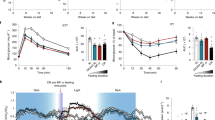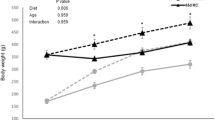Abstract
While dietary restriction (DR) increases maximum life span in many animal species, the mechanisms by which this is achieved remain unclear. One possibility is that DR may act in part to reduce free radical levels by retarding age-related declines in rat liver catalase activity. We measured liver cytosolic catalase activity at various times of day in 9–12 month old male (BN X F344)F1 rats fed ad libitum (AL) or subjected to a 30% DR from 14 weeks of age. Catalase activity (expressed as μmol·min−1·g liver−1) in both diet groups reached minimums at 0600 h but activity was 26% higher in DR as compared to AL rats. This traditional expression of catalase activity did not significantly differ between diet groups at other times of day. One must be careful in the interpretation of such data, however, since catalase is rapidly inactivated by its substrate (H2O2), thus displaying abnormal enzyme kinetics. In order to avoid this difficulty we evaluated the time period during which the reaction remained linear and multiplied it by its activity to yield the effective catalase activity. Using this method we found a significant increase in catalase activity in DR animals at several H2O2 concentrations during the light span. At 1800 h (the beginning of the dark span when the controls initiated peak food intake), fewer and smaller dietary differences were observed and no dietary effects were observed at 2400 h. These data suggest that DR reduces the rate of accumulation of inactive catalase and may contribute to an increased capacity in DR animals to remove free radicals.
Similar content being viewed by others
References
Weindruch R and Walford RL: The Retardation of Aging and Disease by Dietary Restriction. Charles C. Thomas, Springfield, IL., 1988.
Masoro EJ: Food restriction in rodents: an evaluation of its role in the study of aging. J. Gerontol. Biol. Sci. 43:B59–64, 1988.
Yu BP, Laganiere S and Kim J-W: Influence of life-prolonging food restriction on membrane lipoperoxidation and antioxidant status in Oxygen Radicals in Biology and Medicine edited by Simic, MG et al., New York, Plenum, 1989, pp. 1067–1073.
Koizumi A, Weindruch R and Walford RL: Influences of dietary restriction and age on liver enzyme activities and lipid peroxidation in mice. J. Nutr. 117:361–367, 1987.
Langaniere S and Yu BP: Effect of chronic food restriction in aging rats. II. Liver cytosolic antioxidants and related enzymes. Mech. Ageing Dev. 48:221–230, 1989.
Semsei I, Rao G and Richardson A: Changes in the expression of superoxide dismutase and catalase as a function of age and dietary restriction Biochem. Biophys. Res. Comm. 164:620–625, 1989.
Rao G, Xia E, Nadakavukaren MJ and Richardson A: Effect of dietary restriction on the age-dependent changes in the expression of antioxidant enzymes in rat liver. J. Nutr. 120:602–609, 1990.
Baird MB and Samis HV, Jr: Regulation of catalase activity in mice of different ages. Geronologia (Basel) 17:105–115, 1971.
Haining JL and Legan JS: Catalase turnover in rat liver and kidney as a function of age. Exp. Gerontol. 8:85–91, 1973.
Imre S and Juhasz E: The effect of oxidative stress on inbred mice of different ages. Mech. Ageing Dev. 38:259–266, 1987.
Chance B, Sies H and Boveris A: Hydroperoxide metabolism in mammalian organs. Physiol Rvs. 59: 527–605, 1979.
Houve HM, Plemont J and Gaillard J: Interaction between pyridine adenine dinucleotides and bovine liver catalase. Arch. Biochem. Biophys. 248:71–79, 1986.
Kirkam HN, Galiano S and Gaetani GF: The function of catalase-bound NADPH. J. Biol. Chem. 262: 660–666, 1987.
Aebi H: Catalase in vitro. Methods in Enzymol. 105:121–126, 1984.
Duffy PH, Feuers RJ, Leakey JA, Turturro A and Hart RW: Effect of caloric restriction on physiological variables related to energy metabolism in the male Fischer 344 rat. Mech. Ageing Dev. 48:117–133, 1989.
Feuers RJ, Hunter JD, Tsai TH and Scheving LE: Circadian stage dependent 125I-insulin binding in the liver and epidiymal fat of the mouse in Chronobiology: Its Role in Clinical Medicine, General Biology, and Agriculture (Part A), edited by Hays D, Pauley JE and Reiter RJ, New York, Wiley-Liss, 1990, pp. 529–534.
Leakey JEA, Bunchell B and Hume R: Development of multiple activities of UDP-glucoronyl-transferase in human liver. Biochem. J. 243:859–861, 1987.
Lowry OH, Rosebrough NJ, Farr AL and Randall RJ: Protein measurement with the Folin phonol reagent. J. Biol. Chem. 193:265–275, 1951.
Feuers, RJ, Pattillo, FM, Osborn, CK, Adams, KL, DeLuca, D, and Smith, WG: Application of an integrated rate equation to the inactivation of catalase. Free Rad. Biol. Med. 15:223–226, 1993.
Halberg F, Johnson EA, Nelson W, Runge W and Sothern RB: Autorhythmometry procedures for physiological self-measurements and their analysis. Physiol. Teacher 1:1–11, 1972.
Johansson LH and Borg LAH: A spectrophotometric method for determination of catalase activity in small tissue samples. Anal. Biochem. 174:331–336, 1988.
Yu BP, Masoro EJ, Murata I, Bertrand HA and Lynd FT: Life-span study of SPF Fischer 344 male rats fed ad libitum or restricted diets: longevity, growth, lean body mass and disease. J. Gerontol. 37:130–141, 1982.
Feuers RJ and Scheving LE: Chronobiology of hepatic enzymes. Ann. Rev. Chronopharm. 4:209–256, 1988.
Feuers RJ, Delongchamp RR, Kramer S, Scheving LE and Casciano DA: The effect of age on the circadian rhythms of 23 liver or brain enzymes form C57BL/6J mice. Gerontology 31:46–53, 1985.
Duffy PH, Feuers RJ, and Hart RW: Effect of chronic caloric restriction on the circadian regulation of physiological and behavioral variables in old male B6C3F1 mice. Chronbiol. Intl. 7:291–303, 1990.
Mote PL, Grizzle JM, Walford RL and Spindler SR: Influence of age and caloric restriction on expression of hepatic genes for xenobiotic and oxygen metabolizing enzymes in the mouse. Gerontol: Biol. Sci., 46:B95–100, 1991.
Author information
Authors and Affiliations
About this article
Cite this article
Feuers, R.J., Weindruch, R., Leakey, J.E. et al. Increased effective activity of rat liver catalase by dietary restriction. AGE 20, 215–220 (1997). https://doi.org/10.1007/s11357-997-0021-1
Issue Date:
DOI: https://doi.org/10.1007/s11357-997-0021-1




